Looking to improve the performance and efficiency of your 4×4? Paul Guinness takes a look at what’s available to get more from your engine
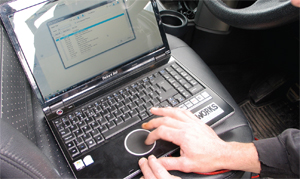 Most folk are probably perfectly happy with their diesel-powered 4x4s, SUVs and off-roaders. They manage to offer reliable, sturdy motoring, reasonable power and decent enough torque in most cases. And if those who crave more performance choose to run a petrol-powered 4×4 instead, perhaps usurping a Td5 Discovery in favour of a V8, then they’re probably content to spend more on fuel in return for that extra on-road ‘oomph’.
Most folk are probably perfectly happy with their diesel-powered 4x4s, SUVs and off-roaders. They manage to offer reliable, sturdy motoring, reasonable power and decent enough torque in most cases. And if those who crave more performance choose to run a petrol-powered 4×4 instead, perhaps usurping a Td5 Discovery in favour of a V8, then they’re probably content to spend more on fuel in return for that extra on-road ‘oomph’.
Sometimes, though, even the most contented drivers crave just a bit more power, or some extra response when their right foot is applied to the ‘go’ pedal. And when it comes to towing or even off-roading, a bit of extra torque could be handy on occasions.
Assuming you don’t have limitless funds available, however, it doesn’t always make sense to change your 4×4 for a more powerful model, given how much extra you’d almost certainly end up spending. So what’s the alternative? Simply this: improve what you already have. Paul Guinness offers a guiding hand through the maze of aftermarket products and services to get that little bit more from your 4×4’s engine.

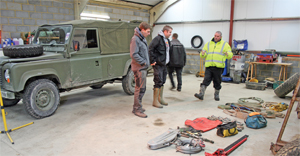 Imagine this scenario: before officially tying the knot, the appeal of one last epic adventure with your best mate is soon concocted over several pints of the best British ale. Africa is earmarked, with Kenya the end game and several weeks on a plan is in motion, now that you’re the winning bidder of a 1995 Land Rover Defender 110. However, the adventurous pair in question, groom-to-be electrician Lewis Ashley and farming machinery specialist Kris Romney, are expedition newbies and under no illusion that they need to learn the necessary skills for their planned adventure. Sensibly, they sign up to an intensive three-day True Grip Off Road expedition preparation course – and I tag along too for good measure.
Imagine this scenario: before officially tying the knot, the appeal of one last epic adventure with your best mate is soon concocted over several pints of the best British ale. Africa is earmarked, with Kenya the end game and several weeks on a plan is in motion, now that you’re the winning bidder of a 1995 Land Rover Defender 110. However, the adventurous pair in question, groom-to-be electrician Lewis Ashley and farming machinery specialist Kris Romney, are expedition newbies and under no illusion that they need to learn the necessary skills for their planned adventure. Sensibly, they sign up to an intensive three-day True Grip Off Road expedition preparation course – and I tag along too for good measure.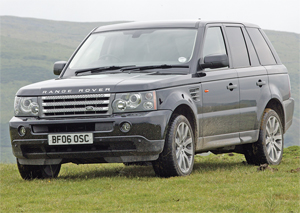 When the all-new Range Rover of 2002 appeared it was a stunning departure from the original concept. Gone was the separate steel chassis, gone were the beam axles, and gone was the trusty old Buick V8 engine. With its all-independent suspension and sleek new styling it was the starkest indication yet that the Range Rover was no longer the estate manager’s town car, it was intended to be one of the world’s best luxury limousines with four-wheel drive, almost an incidental fop to the growing interest in all-wheel drive SUVs. The transformation was fuelled by financial and technical input from BMW and Ford, which had sequentially owned the Land Rover brand at that time; hence there was also a quantum leap in the build quality and the promise of better performance, economy and reliability from new engines and transmissions.
When the all-new Range Rover of 2002 appeared it was a stunning departure from the original concept. Gone was the separate steel chassis, gone were the beam axles, and gone was the trusty old Buick V8 engine. With its all-independent suspension and sleek new styling it was the starkest indication yet that the Range Rover was no longer the estate manager’s town car, it was intended to be one of the world’s best luxury limousines with four-wheel drive, almost an incidental fop to the growing interest in all-wheel drive SUVs. The transformation was fuelled by financial and technical input from BMW and Ford, which had sequentially owned the Land Rover brand at that time; hence there was also a quantum leap in the build quality and the promise of better performance, economy and reliability from new engines and transmissions.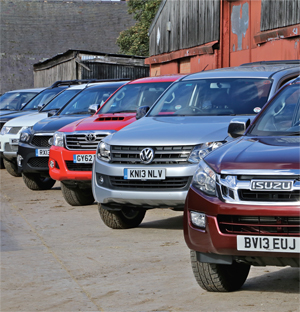 After our annual 4×4 Of The Year test in the last issue, we turn our attention to the pick-up market. With models from China, Korea, Japan (and Japan via the USA) this is a small, but highly competitive selection of 4x4s, and it’s a market enjoying some growth. From the adjoining table, you can see that since 2009, UK pick-up registrations have risen significantly, and this year looks like being particularly strong. Now all these pick-ups have important characteristics in common; all diesel powered, all double cab, and all but one with selectable 4WD. They do, however, have very different characteristics and achieve the common aim of carrying four passengers, significant payload, and being able to tow, in very different ways. Prices too, vary widely. We have reported the manufacturer’s claimed basic prices, which all exclude VAT (since in most cases, this is reclaimable), and that means the most expensive model here, the VW Amarok, is close to twice the cost of the cheapest, the Great Wall Steed. For vehicles that are so matched in their main raison d’etre, this is a significant difference. Is it worth that extra expense?
After our annual 4×4 Of The Year test in the last issue, we turn our attention to the pick-up market. With models from China, Korea, Japan (and Japan via the USA) this is a small, but highly competitive selection of 4x4s, and it’s a market enjoying some growth. From the adjoining table, you can see that since 2009, UK pick-up registrations have risen significantly, and this year looks like being particularly strong. Now all these pick-ups have important characteristics in common; all diesel powered, all double cab, and all but one with selectable 4WD. They do, however, have very different characteristics and achieve the common aim of carrying four passengers, significant payload, and being able to tow, in very different ways. Prices too, vary widely. We have reported the manufacturer’s claimed basic prices, which all exclude VAT (since in most cases, this is reclaimable), and that means the most expensive model here, the VW Amarok, is close to twice the cost of the cheapest, the Great Wall Steed. For vehicles that are so matched in their main raison d’etre, this is a significant difference. Is it worth that extra expense? Oh, sure, we laughed at the Jimny when it appeared in 1998, far too small to be a useful SUV, too puny and low-slung to be a competent off-roader, surely it was nothing more than a nippy, traffic-dodging, easy-park city car, a little kinky in the styling department but hardly more desirable than a Mini…
Oh, sure, we laughed at the Jimny when it appeared in 1998, far too small to be a useful SUV, too puny and low-slung to be a competent off-roader, surely it was nothing more than a nippy, traffic-dodging, easy-park city car, a little kinky in the styling department but hardly more desirable than a Mini…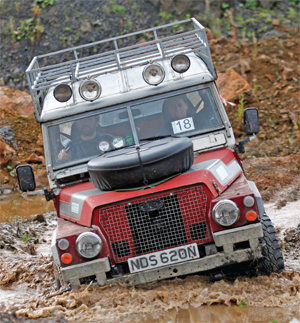 Mudmaster is planned with military precision; “improving road safety, developing both on and off-road driving and map reading skills”, the organisers say, and it does all of these and more. So what can crews expect? All action navigation, trials, autotests, regularity runs and orienteering through forest, over field and quarry sites across central Scotland. This year a dozen or so MAN SV military trucks are in the mix, going through their off-road paces on various sites; they are truly impressive, with semi auto selectable boxes and diff locks to die for. What if they got stuck? The army has the latest recovery answer on site – a 32 ton MAN heavy recovery truck capable of retrieving the heaviest vehicles on operations. Powered by a 440bhp, 10.5-litre, Euro 4 compliant six cylinder turbo diesel engine, it has 8×8 wheel drive and self-levelling suspension to negotiate rough ground. It can pluck a truck right out of the mud with a lifting capacity of 15 tons at a distance of 2.3m, and can tow a 44 ton vehicle should the need arise. It’s well impressive.
Mudmaster is planned with military precision; “improving road safety, developing both on and off-road driving and map reading skills”, the organisers say, and it does all of these and more. So what can crews expect? All action navigation, trials, autotests, regularity runs and orienteering through forest, over field and quarry sites across central Scotland. This year a dozen or so MAN SV military trucks are in the mix, going through their off-road paces on various sites; they are truly impressive, with semi auto selectable boxes and diff locks to die for. What if they got stuck? The army has the latest recovery answer on site – a 32 ton MAN heavy recovery truck capable of retrieving the heaviest vehicles on operations. Powered by a 440bhp, 10.5-litre, Euro 4 compliant six cylinder turbo diesel engine, it has 8×8 wheel drive and self-levelling suspension to negotiate rough ground. It can pluck a truck right out of the mud with a lifting capacity of 15 tons at a distance of 2.3m, and can tow a 44 ton vehicle should the need arise. It’s well impressive. For an off-road enthusiast who believes big is beautiful, there can be few more awe-inspiring sights than watching a six-wheel drive Scammell clambering over a huge rocky outcrop or seeing a Stalwart emerge from a lake and without a pause clamber up the bank and disappear into the undergrowth. Most people do simply look on in awe, because the thought of driving one of these beasts, let alone actually owning one, seems a dream too far, partly because of a natural fear of their perceived complexity and partly because of the assumed high cost of purchasing one, not to mention having to acquire the necessary heavy vehicle driving licence. That latter point aside, most of these all-wheel drive behemoths are actually quite easy to drive, the basic controls are all as straightforward as in an ordinary passenger car, you may just have to spend some time getting used to the pre-selector gearboxes and exhaust brakes sometimes included in the specification of more modern vehicles. As to the cost of purchase, you needn’t pay more for a big six-wheeled off-roader than you would for a good-condition ordinary four-wheel drive. What you will have to consider, however, is that you’ll need somewhere to park it when it’s not in use and if you don’t treat it with respect you could end up frightening yourself with repair and maintenance costs. If neither of these factors causes you concern, then maybe it really is the right time to have a look around at what’s available in the way of heavy-duty awe-inspirers.
For an off-road enthusiast who believes big is beautiful, there can be few more awe-inspiring sights than watching a six-wheel drive Scammell clambering over a huge rocky outcrop or seeing a Stalwart emerge from a lake and without a pause clamber up the bank and disappear into the undergrowth. Most people do simply look on in awe, because the thought of driving one of these beasts, let alone actually owning one, seems a dream too far, partly because of a natural fear of their perceived complexity and partly because of the assumed high cost of purchasing one, not to mention having to acquire the necessary heavy vehicle driving licence. That latter point aside, most of these all-wheel drive behemoths are actually quite easy to drive, the basic controls are all as straightforward as in an ordinary passenger car, you may just have to spend some time getting used to the pre-selector gearboxes and exhaust brakes sometimes included in the specification of more modern vehicles. As to the cost of purchase, you needn’t pay more for a big six-wheeled off-roader than you would for a good-condition ordinary four-wheel drive. What you will have to consider, however, is that you’ll need somewhere to park it when it’s not in use and if you don’t treat it with respect you could end up frightening yourself with repair and maintenance costs. If neither of these factors causes you concern, then maybe it really is the right time to have a look around at what’s available in the way of heavy-duty awe-inspirers.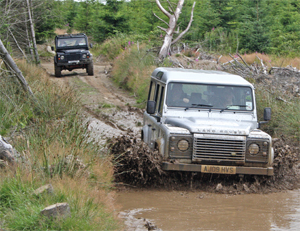 If you’re keen to test your 4×4 away from the metalled highway, you effectively have three options. Pay and play sites, greenlaning or an off-road centre. We decided to head to one of the latter, David Mitchell’s Landcraft in Bala, Snowdonia. Personally, I thought it would be an intriguing opportunity to put my own Land Rover Discovery through its paces, and to see what other vehicles and drivers would be there. We could also find out what made people choose this experience over other options.
If you’re keen to test your 4×4 away from the metalled highway, you effectively have three options. Pay and play sites, greenlaning or an off-road centre. We decided to head to one of the latter, David Mitchell’s Landcraft in Bala, Snowdonia. Personally, I thought it would be an intriguing opportunity to put my own Land Rover Discovery through its paces, and to see what other vehicles and drivers would be there. We could also find out what made people choose this experience over other options. TARGET PRICE: £10,000 – £15,000
TARGET PRICE: £10,000 – £15,000